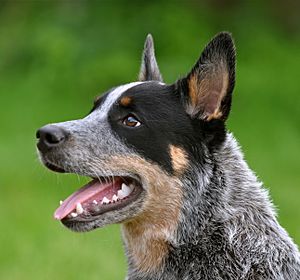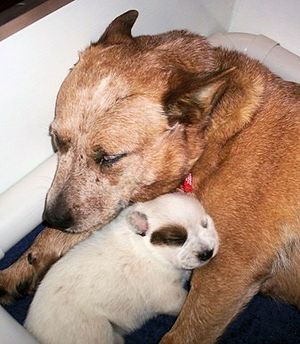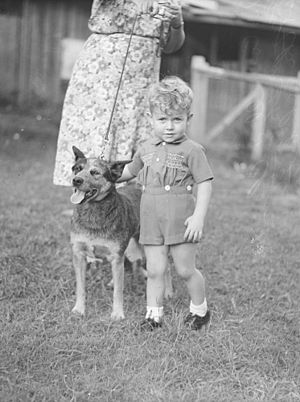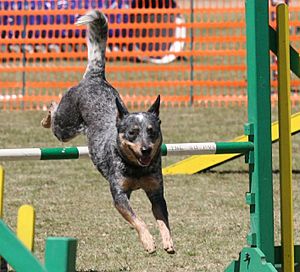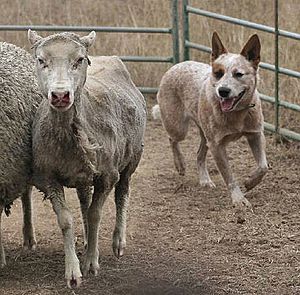Australian Cattle Dog facts for kids
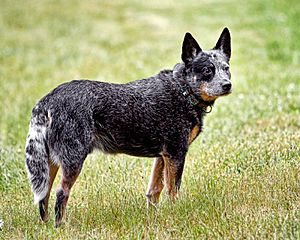
A blue Australian Cattle Dog
|
||||||||||||||||||||||||||
| Other names | ACD, Cattle Dog, Blue Heeler, Red Heeler, Queensland Heeler | |||||||||||||||||||||||||
|---|---|---|---|---|---|---|---|---|---|---|---|---|---|---|---|---|---|---|---|---|---|---|---|---|---|---|
| Origin | Australia | |||||||||||||||||||||||||
|
||||||||||||||||||||||||||
|
||||||||||||||||||||||||||
| Domestic dog (Canis lupus familiaris) | ||||||||||||||||||||||||||
The Australian Cattle Dog (ACD), or simply Cattle Dog, is a breed of herding dog originally developed in Australia for droving cattle over long distances across rough terrain. This breed is a medium-sized, short-coated dog that occurs in two main colour forms. It has either brown or black hair distributed fairly evenly through a white coat, which gives the appearance of a "red" or "blue" dog.
As with dogs from other working breeds, the Australian Cattle Dog is energetic and intelligent with an independent streak. It responds well to structured training, particularly if it is interesting and challenging. It was originally bred to herd by biting, and is known to nip running children. It forms a strong attachment to its owners, and can be protective of them and their possessions. It is easy to groom and maintain, requiring little more than brushing during the shedding period. The most common health problems are deafness and progressive blindness (both hereditary conditions) and accidental injury; otherwise, it is a robust breed with a lifespan of 12 to 14 years.
In the 19th century, New South Wales cattle farmer Thomas Hall crossed the dogs used by drovers in his parents' home county, Northumberland, with dingoes he had tamed. The resulting dogs were known as Halls Heelers. After Hall's death in 1870, the dogs became available beyond the Hall family and their associates. They were subsequently developed into two modern breeds: the Australian Cattle Dog and the Australian Stumpy Tail Cattle Dog. Robert Kaleski, who wrote the first standard for the breed, was influential in its development.
Australian Cattle Dog has been nicknamed a "Red Heeler" or "Blue Heeler" on the basis of its colouring and practice of moving reluctant cattle by nipping at their heels. Dogs from a line bred in Queensland, Australia, which were successful at shows and at stud in the 1940s, were called "Queensland Heelers" to differentiate them from lines bred in New South Wales; this nickname is now occasionally applied to any Australian Cattle Dog.
Contents
Characteristics
Appearance
The Australian Cattle Dog is a sturdy, muscular, compact dog that gives the impression of agility and strength. It has a broad skull that flattens to a definite stop between the eyes, with muscular cheeks and a medium-length, deep, powerful muzzle. The ears are pricked, small to medium in size and set wide apart, with a covering of hair on the inside. The eyes are oval and dark, with an alert, keen expression. The neck and shoulders are strong and muscular; the forelegs are straight and parallel; and the feet round and arched, with small, sturdy toes and nails.
The Australian Cattle Dog breed standard states that it should have well-conditioned muscles, even when bred for companion or show purposes, and that its appearance should be symmetrical and balanced, with no individual part of the dog exaggerated. It should not look either delicate or cumbersome, as either characteristic limits the agility and endurance that is necessary for a working dog.
Size
The female Australian Cattle Dog measures approximately 43–48 centimetres (17–19 in) at the withers, and the male measures about 46–51 centimetres (18–20 in) at the withers. The dog should be longer than tall, that is, the length of the body from breast bone to buttocks is greater than the height at the withers, in a ratio of 10 to 9. An Australian Cattle Dog in good condition weighs around 18–25 kilograms (40–55 lb).
Coat and colour
There are two accepted coat colours, red and blue. Chocolate and cream are considered to be faults. Blue dogs can be blue, blue mottled, or blue speckled with tan on the legs and chest and white markings and a black patch or "mask" on one or both sides of the head. Sometimes black patches are also found on the body. Red dogs are evenly speckled with solid red markings and similarly to the blue dogs can have a brown (red) patch "mask" on one or both sides of the head and sometimes on the body.
Both red dogs and blue dogs are born white (except for any solid-coloured body or face markings) and the red or black hairs show from around 4-weeks of age as they grow and mature. The distinctive adult colouration is the result of black or red hairs closely interspersed through a predominantly white coat. This is not merle colouration (a speckled effect that has associated health issues), but rather the result of the ticking gene. A number of breeds show ticking, which is the presence of colour through white areas, though the overall effect depends on other genes that will modify the size, shape and density of the ticking.
In addition to the primary colouration, an Australian Cattle Dog displays some patches of solid or near-solid colour. In both red and blue dogs, the most common are masks over one or both eyes, a white tip to the tail, a solid spot at the base of the tail, and sometimes solid spots on the body, though these are not desirable in dogs bred for conformation shows. Blue dogs can have tan midway up the legs and extending up the front to breast and throat, with tan on jaws, and tan eyebrows. Both colour forms can have a white "star" on the forehead called the "Bentley Mark", after a legendary dog owned by Tom Bentley. Common miscolours in the Australian Cattle Dog are black hairs in a red-coated dog, including the extreme of a black saddle on a red dog, and extensive tan on the face and body on a blue dog, called "creeping tan". The Australian Cattle Dog has a double coat—the short, straight outer guard hairs are protective in nature, keeping the elements from the dog's skin while the undercoat is short, fine and dense.
The mask consists of a black patch over one or both eyes (for the blue coat colour) or a red patch over one or both eyes (for the red coat colour). Depending on whether one or both eyes have a patch, these are called, respectively, "single" (or "half") mask and "double" (or "full") mask. Dogs without a mask are called plain-faced. Any of these are acceptable according to the breed standard. In conformation shows, even markings are preferred over uneven markings.
Tail
The breed standards of the Australian, American and Canadian kennel clubs specify that the Australian Cattle Dog should have a natural, long, un-docked tail. There will often be a solid colour spot at the base of the tail and a white tip. The tail should be set moderately low, following the slope of the back. It should hang in a slight curve at rest, though an excited dog may carry its tail higher. The tail should feature a reasonable level of brush.
In the United States, tails are sometimes docked on working stock. The tail is not docked in Australia, and serves a useful purpose in increasing agility and the ability to turn quickly. The Australian Cattle Dog is a breed distinct from the Australian Stumpy Tail Cattle Dog, a square-bodied dog born with a naturally "bobbed" tail. The Stumpy Tail resembles the Australian Cattle Dog, but has a taller, leaner conformation. It occasionally has a natural long thin tail, but most are born without tails.
Temperament
Like many working dogs, the Australian Cattle Dog has high energy levels, an active mind, and a level of independence. The breed ranks 10th in Stanley Coren's The Intelligence of Dogs, rated as one of the most intelligent dogs ranked by obedience command trainability. The Cattle Dog needs plenty of exercise, companionship and a job to do, so a non-working dog might participate in dog sports, learning tricks, or other activities that engage its body and mind.
When on home ground, the Australian Cattle Dog is an affectionate and playful pet. However, it is reserved with people it does not know and naturally cautious in new situations. Its attitude to strangers makes it an excellent guard dog when trained for this task, and it can be socialised to become accustomed to a variety of people from an early age as a family pet. It is good with older, considerate children, but will herd people by nipping at their heels, particularly younger children who run and squeal.
While an Australian Cattle Dog generally works silently, it will bark in alarm or to attract attention. It has a distinctive intense, high-pitched bark. Barking can be a sign of boredom or frustration, although research has shown that pet dogs increase their vocalisation when raised in a noisy environment. It responds well to familiar dogs, but when multiple dogs are present, establishing a pecking order can trigger aggression. It is not a breed that lives in a pack with other dogs.
As pets
Grooming
Known as a "wash and wear" dog, the Australian Cattle Dog requires little grooming, and an occasional brushing is all that is required to keep the coat clean and odour-free. Even for the show ring it needs no more than wiping down with a moist cloth. It is not a year-round shedder but blows its coat once a year (twice in the case of intact females) and frequent brushing and a warm bath during this period will contain the shedding hair. As with all dogs, regular attention to nails, ears and teeth will help avoid health problems.
Training
In Katherine Buetow's guide to the Australian Cattle Dog, Ian Dunbar makes the point that while people think of dog training as teaching a dog to sit, speak and roll over, the dog already knows how to do these things. Training, he says, involves teaching the dog that it is a good idea to do these things when a particular word is said or signal is given. He goes on to explain his belief that training is about opening communication channels, so that the dog knows what the handler wants it to do, and knows that it will be worth its while to do it. Consequences for the dog can be rewards for doing what is required, as recommended by Dunbar, or corrections where an unwanted behaviour is performed. Like other working breeds, the Australian Cattle Dog is intelligent and responsive; both of these traits can be an advantage in training where a structured, varied program is used, but can lead to unwanted outcomes if training is not consistent, or is repetitive and boring for the dog. Stock dog trainer Scott Lithgow recommends making training a game so the Cattle Dog learns that obedience leads to enjoyment. Many of a Cattle Dog's natural behaviours are undesirable in a pet: barking, chewing, chasing, digging, defending territory, and nipping heels. Training, therefore, involves helping the dog adopt a lifestyle that is probably very different from that of its droving ancestors. The Australian Cattle Dog is biddable, and responds well to training.
Activities
The Australian Cattle Dog demands a high level of physical activity. Like many other herding dog breeds, the Cattle Dog has an active and fertile mind and if it is not given jobs to do it will find its own activities. It will appreciate a walk around the neighbourhood, but it needs structured activities that engage and challenge it, and regular interaction with its owner. While individual dogs have their own personalities and abilities, as a breed the Australian Cattle Dog is suited to any activity that calls for athleticism, intelligence, and endurance.
Kennel club-sponsored herding trials with a range of events suit the driving abilities of the Cattle Dog and other upright breeds, while sheepdog trials are more suited to the "eye" breeds such as the Border Collie and Australian Kelpie. Herding instincts and trainability are measured at non-competitive herding tests, and basic commands are sometimes taught through herding games, where rules such as "stay", "get it" and "that'll do" are applied to fetching a ball or chasing a yard broom.
The Australian Cattle Dog was developed for its ability to encourage reluctant cattle to travel long distances and may be the best breed in the world for this work. However, some working dog trainers have expressed concern that dogs bred for the show ring are increasingly too short in the legs and too stocky in the body to undertake the work for which they were originally bred.
Among the most popular activities for an Australian Cattle Dog is dog agility. It is ideally suited for navigating obstacle courses, since as a herding dog it is reactive to the handler's body language and willing to work accurately at a distance from the handler. Agility has been used by Cattle Dog owners to instil confidence in their dogs, and enhance their performance in training and competition.
The Australian Cattle Dog thrives on change and new experiences, and many handlers find training the breed challenging for this reason. An Australian Cattle Dog can excel in obedience competition. It will enjoy the challenges, such as retrieving a scented article, but the breed's problem-solving ability may lead it to find solutions to problems that are not necessarily rewarded by the obedience judges. Rally obedience offers more interaction with the owner and less repetition than traditional obedience trials.
Australian Cattle Dogs have been successful in a range of dog sports including weight pulling, flyball and schutzhund. The breed is particularly suited to activities that a dog can share with its owner such as canicross, disc dog, and skijoring or bikejoring. It is an effective hiking companion because of its natural endurance, its general lack of interest in hunting, and preference for staying by its owner's side. Most Australian Cattle Dogs love the water and are excellent swimmers. It is not a hyperactive breed, and once one has had its exercise, it is happy to lie at its owner's feet, or to rest in its bed or crate while keeping an ear and eye open for signs of pending activity. The Australian Cattle Dog is an adaptable dog that can accept city or indoor living conditions, if its considerable exercise and companionship needs are met.
The Australian Cattle Dog can be put to work in a number of ways. Cattle Dogs are service dogs for people with a disability or are therapy dogs, some work for customs agencies in drug detection, some as police dogs, others haze pest animals, such as geese, for city or state agencies, and some work as scat-detection dogs, tracking endangered wildlife species.
Health and lifespan
Lifespan
In a small sample of 11 deceased dogs, Australian Cattle Dogs had a median longevity of 11.7 years (maximum 15.9 yrs). A larger survey of 100 deceased dogs yielded a mean longevity of 13.41 years with a standard deviation of 2.36 years. The median longevities of breeds of similar size are between 11 and 13 years.
There is an anecdotal report of a Cattle Dog named Bluey, born in 1910 and living for 29.5 years, but the record is unverified. Even if true, Bluey's record age would have to be regarded more as an uncharacteristic exception than as an indicator of common exceptional longevity for the entire breed. It remains, however, that Australian Cattle Dogs generally age well and appear to live on average almost a year longer than most dogs of other breeds in the same weight class. Many members of the breed are still well and active at 12 or 14 years of age, and some maintain their sight, hearing and even their teeth until their final days.
Related Pages
Images for kids
-
US soldiers met the Cattle Dog mascots of Australian divisions overseas. This puppy is being bathed in preparation for a visit by General Douglas MacArthur.
See also
 In Spanish: Pastor ganadero australiano para niños
In Spanish: Pastor ganadero australiano para niños


